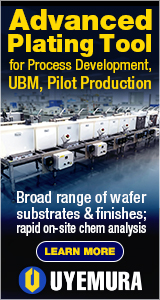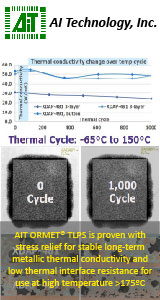|

|
|
| Ask the Experts | |||||||
|
|||||||
|
September 8, 2017 - Updated October 22, 2007 - Originally Posted Ultrasonic cleaning PCB's after wave solderWe are using an ultrasonic cleaning system for cleaning PCBs after wave soldering. We are not allowing much time for the board temperature, which is 245 degrees centigrade at the time wave soldering to cool. Is this a correct methodology and are there precautions that should be followed? V. S. |
|||||||
| Expert Panel Responses | |||||||
|
The ultrasonic cleaning system is only the method of mechanical agitation or "scrubbing" action. Optimal cleaning temperature for most ultrasonic cleaning applications is between 120 - 140 degrees F (49 - 60 degrees C). Occasionally, the application will dictate the allowable temperature. For example: stencil cleaning requires low temperatures less than 110 degrees F (43 degrees C) because stencils are heat-sensitive. At temperatures higher than 140 degrees F the cleaning media becomes difficult to cavitate and the ultrasonic scrubbing action is therefore diminished. By immersing boards at 245 degrees C (475 degrees F) the cleaning media surrounding the board will become "super heated" and diminish the effects of ultrasonic cavitation around the board and decrease the effective mechanical scrubbing action. I recommend allowing the boards to cool to below 140 degrees F (60 Degrees C). Another concern should be the "shock" factor of immersing hot boards into relatively cold water. The metal and non metal components of the board will have significantly different expansion/contraction coefficients presenting unnecessary stress on points of metal/non metal junctures. However, the most important feature of any cleaning process is always the cleaning chemistry. That said, I can only speak for the Smart Sonic Ultrasonic Cleaning Process that utilizes 440-R SMT Detergent as the cleaning chemistry. Elevated temperatures will not decrease the cleaning efficiency of 440-R SMT Detergent, but the mechanical action necessary to carry the contaminant away from the substrate will be less effective at temperatures greater than 140 degrees F (60 degrees C). Additional information about ultrasonic cavitation is provided in the Stencil and Misprinted Board Cleaning Handbook (IPC-7526) and is available as a free download.
President Smart Sonic Corporation Mr. Schreiber developed the original ultrasonic stencil cleaning process in 1989. Obtained the only EPA Verification for specific parameters of Environmental Safety, User Safety and Cleaning Efficiency for a stencil cleaning process.
The component temperatures should be 60C or below before contact with water. Otherwise, cracking of components can occur.
CEO & Managing Partner DfR Solutions Dr. Hillman's specialties include best practices in Design for Reliability, strategies for transitioning to Pb-free, supplier qualification, passive component technology and printed board failure mechanisms.
The issue of the PCB temperature will have more to do with the cleaning chemistry you are using and what its recommended operating temperature is. I would discuss the best process suggestions with the supplier of the cleaning agents.
CEO ATEK llc Allen Duck is a 20-year Electronics Industry veteran with Global experience in multiple fields of technology and management. He started A-Tek in 2006 to provide a sales and service channel for international equipment companies wishing to offer value based solutions to USA companies.
As a rule, cleaning is easier soon after the soldering process. As the boards leave the wave soldering process, allow the boards to cool below 70C and then proceed with the cleaning process.
CTO Kyzen Corp. Mr. Bixenman is the CTO for Kyzen Corp. Kyzen Corp. is a leading provider of engineered cleaning fluids for high technology manufacturing environments.
|
|||||||
| Submit A Comment | |||||||
|
Comments are reviewed prior to posting. You must include your full name to have your comments posted. We will not post your email address. |
|
Free Newsletter Subscription
Circuitnet is built for professionals who bear the responsibility of looking ahead, imagining the future, and preparing for it. Insert Your Email Address |
|

|






